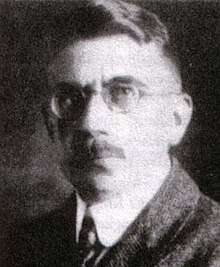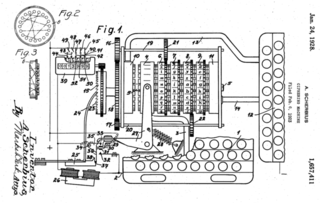Arthur Scherbius
| Arthur Scherbius | |
|---|---|
 Arthur Scherbius, inventor of the Enigma cipher. | |
| Born |
30 October 1878 Frankfurt |
| Died |
13 May 1929 (aged 50) Berlin |
| Nationality | German |
| Education | Technical University Munich & University of Hanover PhD in Engineering |
| Occupation | Engineer |
| Engineering career | |
| Significant design | Enigma machine |

Dr. Arthur Scherbius (30 October 1878 – 13 May 1929) was a German electrical engineer, inventor and pioneer who invented the famous mechanical cipher Enigma machine. He patented the invention, and later sold the machine under the brand name Enigma.
Scherbius offered unequaled opportunities and showed the importance of cryptography to military and civil intelligence.
Life and work
Scherbius was born in Frankfurt am Main, Germany. His father was a businessman.
He studied electrical engineering at the Technical University Munich, and then went on to study at the University of Hanover, finishing in March 1903. The next year, he completed a dissertation titled "Proposal for the Construction of an Indirect Water Turbine Governor", and was awarded a doctorate in engineering (Dr.-Eng.).
Scherbius subsequently worked for a number of electrical firms in Germany and Switzerland. In 1918, he founded the firm of Scherbius & Ritter. He made a number of inventions, e.g. asynchronous motors, electric pillows and ceramic heating parts; his research contributions led to his name being associated with the Scherbius principle for asynchronous motors.
Scherbius applied for a patent (filed 23 February 1918) for a cipher machine based on rotating wired wheels, what is now known as a rotor machine.
His first design of the Enigma was called Model A and was a monster about the size and shape of a cash register (50 kg). Then followed Model B and Model C, that was a portable device in which the letters were indicated by lamps. The Enigma machine looked like a typewriter in a wooden box.
He called his machine Enigma, which is the Greek word for "riddle".
The firm's cipher machine, marketed under the name "Enigma", was initially pitched at the commercial market. There were several commercial models, and one of them was adopted by the German Navy (in a modified version) in 1926. The German Army adopted the same machine (also in a modified version somewhat different from the Navy's) a few years later.
Scherbius was first confronted with problems because no one showed interest or even noticed his invention. However Scherbius was convinced that his Enigma would make a market. After all the German Army was interested in a new cryptographic device because of several disappointments in the past. The serial production of the Enigma started in 1925 and the first machines came into use in 1926.
Scherbius' Enigma provided the German Army with the strongest cryptographic cipher of the world and the military conversation of the Germans was optimally protected during World War II. Scherbius however couldn't experience the success of his machine.
Scherbius died in a horse carriage accident in 1929.
In “Turing’s Cathedral” by George Dyson it is noted that “…a cryptographic machine had been invented by the German electrical engineer Arthur Scherbius, who proposed it to the German navy, an offer that was declined. Scherbius then founded the Chiffriermaschinen Aktiengesellschaft to manufacture the machine, under the brand name Enigma, for enciphering commercial communications, such as transfers between banks. The German navy changed its mind and adopted a modified version of the Enigma machine in 1926, followed by the German army in 1928, and the German air force in 1935”.[1]
Combining three rotors from a set of five, the rotor settings with 26 positions, and the plug board with ten pairs of letters connected, the military Enigma has 158,962,555,217,826,360,000 (nearly 159 quintillion) different settings.
Patents
References
Notes
Bibliography
- David Kahn, Seizing the Enigma: The Race to Break the German U-Boats Codes, 1939–1943 (Houghton Mifflin 1991) ( ISBN 978-0-395-42739-2)